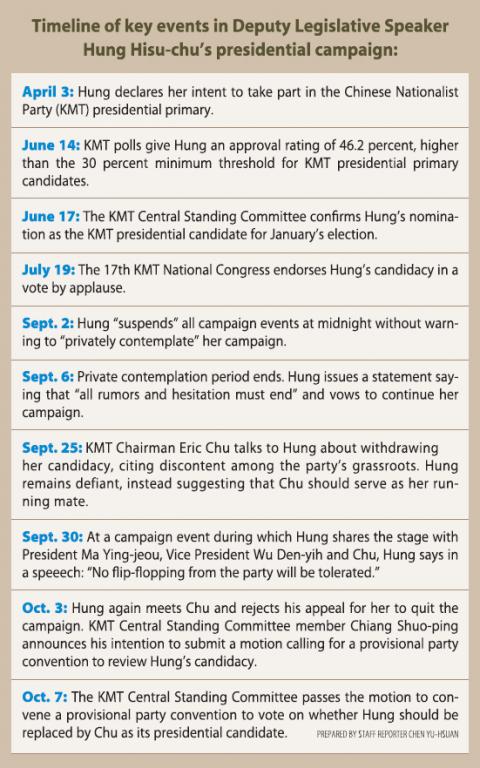There was a time when the Chinese Nationalist Party (KMT) and President Ma Ying-jeou’s (馬英九) administration could console themselves with at least one perceived advantage over the Democratic Progressive Party: their cross-strait policy.
That KMT presidential candidate Hung Hsiu-chu (洪秀柱) managed to squander even that advantage away explains why the KMT now appears it would stop at nothing to annul her candidacy.
The fundamental weakness of Hung’s campaign is her radical pro-unification ideology, which has prompted the top echelons of the Presidential Office, the KMT and “elders” with the pan-blue camp to unite in calls for her to withdraw from the presidential race.

If she were allowed to continue, Hung’s cross-strait platform — a mess for which Hung has only herself to blame — would doom not only her campaign, but also those of KMT legislative candidates.
A KMT rout from the legislature would be the kind of nightmare scenario in which the party’s continued existence would not be guaranteed. Yet Hung apparently remains oblivious to the disaster she has created.
Therefore, KMT leaders have in recent days demonstrated considerable resolve in neutralizing Hung, running roughshod over procedural niceties, as well as public opinion.
The KMT Central Standing Committee on Wednedsay unanimously passed a resolution to call an extraordinary party congress to deliberate a proposal to replace her.
Although the KMT headquarters’ drastic methods prompted criticism, Hung’s stubborn and unthinking refusal to confront the matter has left the KMT no choice — “whatever the costs, Hung must go.”
KMT Chairman Eric Chu (朱立倫) voiced the discontent of grassroots members when he panned her cross-strait policy as out of touch with mainstream public opinion.
However, Hung brushed Chu off and blithely attributed the public furor over her China policy comments to “flawed communication.”
Ultimately, Hung’s self-righteous belief in her role as a champion of “truth,” and her indifference to the survival of KMT legislative candidates, are the reasons the KMT has “collectively disidentified” with Hung.
Hung’s cross-strait stance relies heavily on the ideas of Chang Ya-chung (張亞中), an academic with strong pro-unification views; crucially, Hung’s China policy discourse goes above and beyond Ma’s.
After Hung heedlessly crossed the Ma government’s “China-policy red line,” Ma had no choice but to sever his support for Hung.
A pan-blue camp politician once said that if, for the sake of argument, one concedes that the KMT is “pro-China,” then in comparison with the KMT, Chang and his ilk are “just red.” Left unchecked, the “red tide” from Hung’s campaign would crush the KMT as surely as it has crushed Hung.
Translated by staff writer Jonathan Chin

US climber Alex Honnold is to attempt to scale Taipei 101 without a rope and harness in a live Netflix special on Jan. 24, the streaming platform announced on Wednesday. Accounting for the time difference, the two-hour broadcast of Honnold’s climb, called Skyscraper Live, is to air on Jan. 23 in the US, Netflix said in a statement. Honnold, 40, was the first person ever to free solo climb the 900m El Capitan rock formation in Yosemite National Park — a feat that was recorded and later made into the 2018 documentary film Free Solo. Netflix previewed Skyscraper Live in October, after videos

Starting on Jan. 1, YouBike riders must have insurance to use the service, and a six-month trial of NT$5 coupons under certain conditions would be implemented to balance bike shortages, a joint statement from transportation departments across Taipei, New Taipei City and Taoyuan announced yesterday. The rental bike system operator said that coupons would be offered to riders to rent bikes from full stations, for riders who take out an electric-assisted bike from a full station, and for riders who return a bike to an empty station. All riders with YouBike accounts are automatically eligible for the program, and each membership account

NUMBERS IMBALANCE: More than 4 million Taiwanese have visited China this year, while only about half a million Chinese have visited here Beijing has yet to respond to Taiwan’s requests for negotiation over matters related to the recovery of cross-strait tourism, the Tourism Administration said yesterday. Taiwan’s tourism authority issued the statement after Chinese-language daily the China Times reported yesterday that the government’s policy of banning group tours to China does not stop Taiwanese from visiting the country. As of October, more than 4.2 million had traveled to China this year, exceeding last year. Beijing estimated the number of Taiwanese tourists in China could reach 4.5 million this year. By contrast, only 500,000 Chinese tourists are expected in Taiwan, the report said. The report

Temperatures are forecast to drop steadily as a continental cold air mass moves across Taiwan, with some areas also likely to see heavy rainfall, the Central Weather Administration (CWA) said. From today through early tomorrow, a cold air mass would keep temperatures low across central and northern Taiwan, and the eastern half of Taiwan proper, with isolated brief showers forecast along Keelung’s north coast, Taipei and New Taipei City’s mountainous areas and eastern Taiwan, it said. Lows of 11°C to 15°C are forecast in central and northern Taiwan, Yilan County, and the outlying Kinmen and Lienchiang (Matsu) counties, and 14°C to 17°C